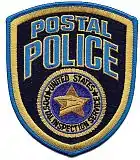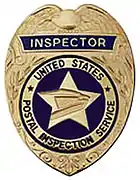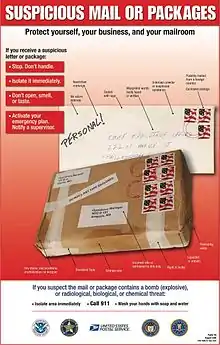United States Postal Inspection Service
The United States Postal Inspection Service (USPIS), or the Postal Inspectors, is the law enforcement arm of the United States Postal Service. It supports and protects the U.S. Postal Service, its employees, infrastructure, and customers by enforcing the laws that defend the nation's mail system from illegal or dangerous use. Its jurisdiction covers any "crimes that may adversely affect or fraudulently use the U.S. Mail, the postal system or postal employees." With roots going back to the late 18th century, the USPIS is the oldest continually operating federal law enforcement agency.[1]
| United States Postal Inspection Service | |
|---|---|
 Patch of the U.S. Postal Inspection Service - Postal Police Uniformed Division | |
 USPIS logo | |
 Badge of a Postal Inspector | |
| Common name | Postal Inspection Service |
| Abbreviation | USPIS |
| Agency overview | |
| Formed | 1775 (surveyors) 1801 (special agents) 1830 (agency) 1880 (post-office inspectors) 1954 (postal inspectors) |
| Employees | 2,500 (approx) |
| Jurisdictional structure | |
| Federal agency | United States |
| Operations jurisdiction | United States |
| General nature | |
| Specialist jurisdiction |
|
| Operational structure | |
| Headquarters | 475 L'Enfant Plaza SW, Washington, D.C. |
| Postal Inspectors | 1,200 (approx) |
| Agency executive |
|
| Parent agency | United States Postal Service |
| Website | |
| www | |
As roughly 200 federal crimes relate to mail, the Postal Inspectors' activities are markedly broad and ever-changing.[2] In 2019, it made 5,759 arrests leading to nearly 5,000 convictions, mostly involving mail theft, mail fraud or contraband mailings. The growth in narcotics trading has resulted in 19,000 arrests and the seizure of $18 million in drug proceeds since 2010.
In fiscal year 2014, USPIS had 2,376 field employees, a decline of 44.7% from fiscal year 1995.[3] In 2008, the U.S. Postal Inspection Service had 2,288 full-time personnel with the authority to make arrests and carry firearms on duty. This represented a 23.1% drop over the previous five years.[4] As of 2019, there are about 1,200 postal inspectors, who are authorized to carry weapons, make arrests, execute federal search warrants, and serve subpoenas.[1]
History
The Postal Inspection Service has the oldest origins of any federal law enforcement agency in the United States. It traces its roots back to 1772[5] when colonial Postmaster General Benjamin Franklin first appointed a "surveyor" to regulate and audit the mails. Thus, the Service's origins—in part—predate the Declaration of Independence, and therefore the United States itself.
As Franklin was appointed Postmaster General under the Second Continental Congress, his system continued. One of Franklin's first acts as Postmaster General was to appoint William Goddard as the first Postal Surveyor of the newly founded American postal system, in charge of inspecting the integrity and security of postal routes, regulating post offices, and auditing their accounts. A letter from Franklin to Goddard, dated August 7, 1775, authorized a total of $170.00 for Goddard to carry out these duties,[6] and so August 7 is recognized as the "birthday" of the U.S. Postal Inspection Service.
In 1801, the title of "surveyor" was changed to special agent. In 1830, the special agents were organized into the Office of Instructions and Mail Depredations. The Postal Inspection Service was the first federal law enforcement agency to use the title special agent for its officers. Congress changed this title to inspector in 1880.
For some time, one of their primary duties was the enforcement of obscenity prohibitions under the Comstock Act, named after Postal Inspector Anthony Comstock.
Jurisdiction and activities
As fact-finding and investigative agents, postal inspectors are sworn federal law enforcement officers who carry firearms, make arrests and serve federal search warrants and subpoenas. Inspectors work closely with U.S. attorneys, other law enforcement agencies, and local prosecutors to investigate postal cases and prepare them for court. For example, on all international mail, postal inspectors work closely with U.S. Customs and Border Protection (CBP) or U.S. Immigration and Customs Enforcement’s Homeland Security Investigations (HSI); while on domestic mail, postal inspectors work closely with state and local law enforcement agencies. There are approximately 1,200 postal inspectors stationed throughout the United States and abroad who enforce more than 200 federal laws covering investigations of crimes that adversely affect or fraudulently use the U.S. Mail and postal system.
The USPIS has responsibility to safeguard over 600,000[7] Postal Service employees and billions of pieces of mail transported worldwide yearly by air, land, rail, and sea.
USPIS was at one time the only investigative agency of the Postal Service; however, with the creation of the USPS Office of Inspector General in 1996, they assumed many duties previously carried out by the USPIS. The USPS OIG conducts independent audits and investigations. Audits of postal programs and operations help to determine whether the programs and operations are efficient and cost-effective. Investigations help prevent and detect fraud, waste, and misconduct and have a deterrent effect on postal crimes.
The OIG primarily took over the Postal Inspection Service's audit function, as well as fraud (against the USPS) waste and abuse.

Since the September 11, 2001, attacks, the USPIS has also investigated several cases where ricin, anthrax, and other toxic substances were sent through the mail. Although the USPIS has a wide jurisdiction, USPIS investigations can be categorized into these seven types of investigative teams and functions:
- Fraud: These types of investigation involve crimes that use the mails to facilitate fraud against consumers, business and government. Federal statutes that surround these types of investigations include, mail fraud, and other criminal statutes when they are tied to the mails such as bank fraud, identity theft, credit card fraud, wire fraud, and Internet/computer fraud. Mail fraud is a statute that is used in prosecuting many white collar crimes, this would include, Ponzi schemes, 419 frauds, and other white collar crimes where the mail was used to facilitate the fraud including public corruption (under the "Honest Services" provision of the federal fraud statutes). In the 1960s and 70s, inspectors under regional chief postal inspectors such as Martin McGee, known as "Mr. Mail Fraud," exposed and prosecuted numerous swindles involving land sales, phony advertising practices, insurance ripoffs and fraudulent charitable organizations using mail fraud charges.[8] McGee is credited with assisting in the conviction of former Illinois governor Otto Kerner on mail fraud charges.[9]
- External Crime and Crime Teams: The External Crimes Function of USPIS is a function that investigates any theft of US mail by non employees, assaults of postal employees and theft and robberies of postal property. This function also investigates robberies of postal employees and postal facilities, burglaries of postal facilities, and assaults and murders against postal employees. This investigative function focuses on ensuring that the sanctity and trust in the U.S. Mail system is maintained.
- Prohibited Mailing Investigations: Prohibited mailing investigations are USPIS investigations that focus on the prohibited mailing of contraband including: narcotics, precursors and proceeds; child pornography and other sexually prohibited materials; and hazardous materials to include, mail bombs, and nuclear, biological and chemical weapons. The laundering of narcotics and other criminal proceeds through the use of postal money orders is sometimes categorized under this investigative function.
- Aviation and Homeland Security: USPIS investigations also include the securing and protecting of transportation of US Mail and any risk that might compromise the security of the homeland because of these mails. Security audits are conducted by these teams to ensure that postal service maintains facilities secure from not only theft and robberies but also natural and manmade disasters.
- Revenue Investigations: USPIS investigates cases where fraudulent practices are conducted by business and consumers that mail items without proper postage or with counterfeit postage and indicia or crimes that defraud the USPS of revenue. Recently, however, they have indicated that they have little interest in pursuing producers of counterfeit stamps.[10]
- International Investigations and Global Security: This investigative function ensures that international mail is secured and any international business decisions and campaigns remains safe, and secure. USPIS maintains investigators in the US and in posts around the world for protection, liaison, and intelligence.
- Joint Task Force Investigations: USPIS participates in joint task force investigations where laws applicable to the mail service are involved. These cases are often wide-ranging and involve every law enforcement agency of the federal government. For example, USPIS participated in the largest count indictment and conviction in NASA history, the Omniplan case, that put seven companies out of business and ended with the conviction of Omniplan owner, Ralph Montijo, on 179 federal crimes.[11][12]
The Postal Inspection Service's Technical Services Unit (TSU) provides investigative support through the use of new technology and the operations of two national communication centers known as the National Law Enforcement Control Centers (NLECC). In 2003, U.S. Immigration and Customs Enforcement renamed their national communication center, previously known as "Sector" to the "National Law Enforcement Communications Center" (also known as NLECC). USPIS NLECC and ICE NLECC are two independent federal law enforcement radio communications centers that coincidentally share the same acronym and an almost identical name.
USPS Forensic Laboratory
The U.S. Postal Inspection Service first established a crime lab in 1940.[13] Today, the main USPS Forensic Laboratory is located in Dulles, Virginia,[14] in a two-story, 44,000-square-foot facility.[15] The lab is staffed by forensic scientists and technical experts and consists of four units: the Questioned Documents Unit, the Fingerprint Unit, the Physical Sciences Unit, and the Digital Evidence Unit.[14] The laboratory is overseen by a laboratory director and each of the four units is overseen by an assistant laboratory director.[15] There are also four satellite offices, located in New York, Chicago, Memphis, and San Francisco.[16] In 2012, the entire U.S. Postal Inspection Service laboratory system had 65 employees (58 scientific staff and seven administrative staff), mostly based in the main Dulles lab.[15]
Police Force

In addition to maintaining a staff of postal inspectors, the Postal Inspection Service has a uniformed force of Postal Police Officers who provide security service at major postal facilities throughout the United States, conduct perimeter security, escort high-value mail shipments, and perform other essential security functions. As of 2018 there were approximately 500 postal police officers nationwide.
USPIS Academy
The Postal Inspection Service maintains a law enforcement academy (the Career Development Unit) based in Potomac, Maryland. It is a federally accredited law enforcement academy by the Federal Law Enforcement Training Accreditation.[17]
Fallen officers
Fourteen US postal inspectors and postal police officers have died in the line of duty.[18] Their names have been etched on the National Law Enforcement Officers Memorial wall and to a Postal Inspection Service plaque at the agency's national headquarters, both located in Washington, D.C.
2 SMRT 4U
In 2006 the Postal Inspection Service created the "2 SMRT 4U" campaign aimed at teenage girls, the group most targeted by online sexual predators. It established the website to educate teens about how to chat and post wisely online.[19] The website has been rebranded NSTeens.org, but still provides educational information for teens. For its dedication to protecting children and fighting child exploitation, the United States Department of Justice honored the Postal Inspection Service with its Internet Safety Award.[20]
See also
References
- Narea, Nicole (August 20, 2020). "The post office arrested Steve Bannon. Yes, the post office can arrest people". Vox. Retrieved August 21, 2020.
- Horton, Alex. "The surprising mission of the Postal Service police who arrested Stephen Bannon". The Washington Post. Retrieved August 21, 2020.
- Francis, Kathryn A. (October 21, 2015). "U.S. Postal Service Workforce Size and Employment Categories, FY1995-FY2014 (page 6, table 2)" (PDF). Federation of American Scientists.
- Reaves, Brian A. (June 2012). "Federal Law Enforcement Officers, 2008" (PDF). Bureau of Justice Statistics, United States Department of Justice.
- "A Chronology of the United States Postal Inspection Service". U.S. Postal Inspection Service. Retrieved August 21, 2020.
- "A Chronology of the United States Postal Inspection Service". U.S. Postal Inspection Service. Archived from the original on April 6, 2016. Retrieved March 30, 2018.
- "Size and Scope – Postal Facts". United States Postal Service. Retrieved April 21, 2014.
- Janega, James (January 14, 2000). "Obituaries: Martin J. McGee, Pioneer In Mail Fraud Investigation". Chicago Tribune. Retrieved May 21, 2015 – via Scribd.com.
- Merriner, James L. (2004). Grafters and Goo Goos: Corruption and Reform in Chicago. Carbondale, Illinois: SIU Press. p. 194. ISBN 978-0-8093-2571-9.
- Crudele, John (May 17, 2018). "I tried to warn USPS about this counterfeit operation". New York Post.
- Myerson, Allen R. (January 17, 1996). "Businessman Is Sentenced For Bilking Space Agency". The New York Times.
- "Omniplan Owners Plead Guilty". The Bay Area Citizen. February 3, 1995.
- Bell, Suzanne (2008). Crime and Circumstance: Investigating the History of Forensic Science. Westport, Connecticut: Praeger. p. 107. ISBN 978-0-31335-386-4.
- "Forensic Laboratory Services". U.S. Postal Inspection Service. Archived from the original on November 23, 2016. Retrieved November 23, 2016.
- Goudarzi, Sara (January 20, 2012). "Perspective On: A Forensics Lab". Lab Manager.
- Schultz, Dorothy Moses (2005). "U.S. Postal Inspection Service". In Sullivan, Larry E.; Rosen, Marie Simonetti (eds.). Encyclopedia of Law Enforcement. Vol. 1. Thousand Oaks, California: SAGE Publications. p. 884. ISBN 978-0-76192-649-8.
- "Accredited Academies". Federal Law Enforcement Training Accredition. Retrieved March 1, 2012.
- "Fallen Officers". U.S. Postal Inspection Service. Retrieved May 20, 2015.
- "NSTeens.org - Making Safer Choices Online". 2smrt4u.com.
- "The National Strategy for Child Exploitation Prevention and Interdiction: A Report to Congress (page 88)" (PDF). U.S. Department of Justice. Retrieved March 1, 2012.
External links
| Wikimedia Commons has media related to United States Postal Inspection Service. |